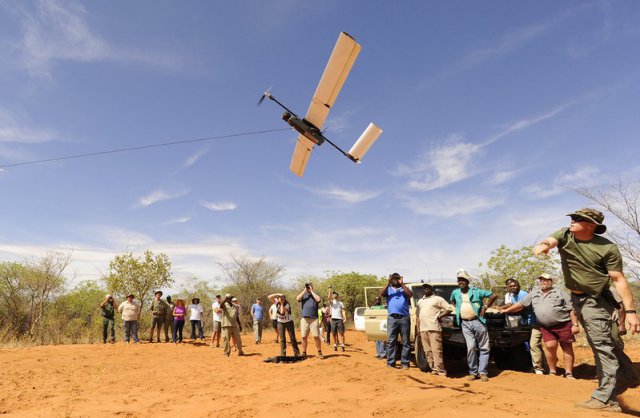The Namibian government has deployed three Falcon Unmanned Aerial Vehicles (UAVs) in conservancies to support the anti-poaching operations by the Namibian Defence Force (NDF) as part of a new ‘aggressive’ strategy to combat an upsurge in the poaching of elephants and rhinos.
Namibia settled for the Falcon UAVs after successful week-long test flights on anti-poaching operations over conservancies around the country in February this year. The programme is funded by the World Wildlife Fund (WWF) through its Wildlife Crime Technology Project.
Several other types of UAVs were test-flown in the selection programme and these include the locally-made SurVoyeur, which is still being test-flown for possible adoption by the government after modifications.
Environment and Tourism minister Uahekua Herunga told the Namibian Sun that the deployment of the UAVs signals the start of a new, aaggressivegovernment strategy to combat an alarming upsurge in the poaching of rhinos and elephants.
He said the country had so far deployed 3 UAVs on anti-poaching operations over affected game parks but will raise the number to eight if it gets additional funding for the programme.
“We have managed to deploy three drones (UAVs) at the moment. If we are able to deploy one in each of the affected regions, we will get better results. We need to have a budgetary allocation for the anti-poaching unit included in the overall budget for the ministry. If we get financing, I think seven to eight drones would be able to do a proper job,” Herunga said.
The ministry also wants additional emergency funding from the government to support the setting up of a rapid reaction Anti Poaching Unit (APU) of the security forces. It is also seeking technical assistance in training more parks rangers on how to operate the UAVs as well as interpreting and processing the information they supply.
“There was no provision for financing the anti-poaching unit in the current budget. Drones are a new technology, our staff have to know how they operate, we need a lot of training to operate the drones,” Herunga said.
The first three UAVs will continue running on a trial basis up to February 2015 when the government will conduct a second evaluation of their effectiveness and decide on whether to continue or stop the programme.
The Falcon is a bungee-launched, parachute recovery UAV which features day and night video payloads, and can be set up and launched in 10 minutes.
It can stay airborne for over 60 minutes and is inter-operable with the Falcon Hover, a tactical Multi-copter Unmanned Vehicle which has Vertical Take Off and Landing (VTOL) capability.
According to the manufacturers of the SurVoyeur, the aircraft is still being test-flown by the government after being fitted with newer, modified camera systems. It is powered by a 4.5kg Hacker A30-12XL electric motor and can carry up to 600 grams in payload while staying airborne for 45 minutes.
More than 33 elephants and 10 rhinos have been killed by poachers in flagship Namibian conservancies which include Bwabwata, Nkasa Rupara, Linyanti and Mudumu national parks in the remote northern-eastern Zambezi district.
In July, the government deployed the army to crack down on poaching in the north-east as it struggles to save an estimated 25 000 elephants and 2 220 rhinos from a worsening poaching crisis.
So far, seven Chinese nationals, one Indian and dozens of their Namibian, Congolese and Zambian accomplices are in Namibian custody or on trial after being arrested with hauls of elephant and rhino ivory and artefacts among other protected wildlife products.
Source: Defence Web

